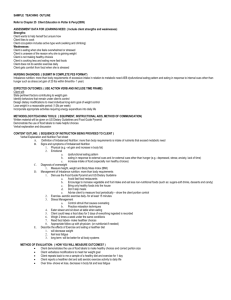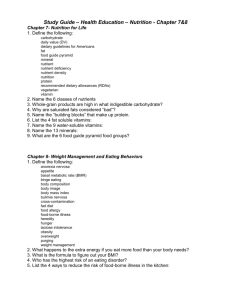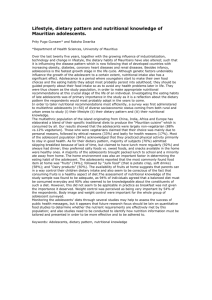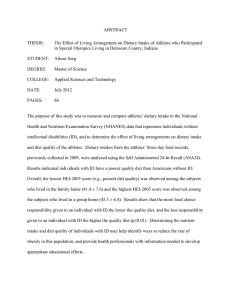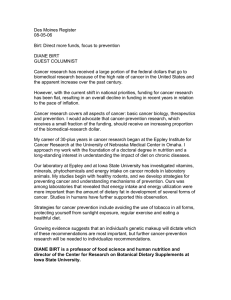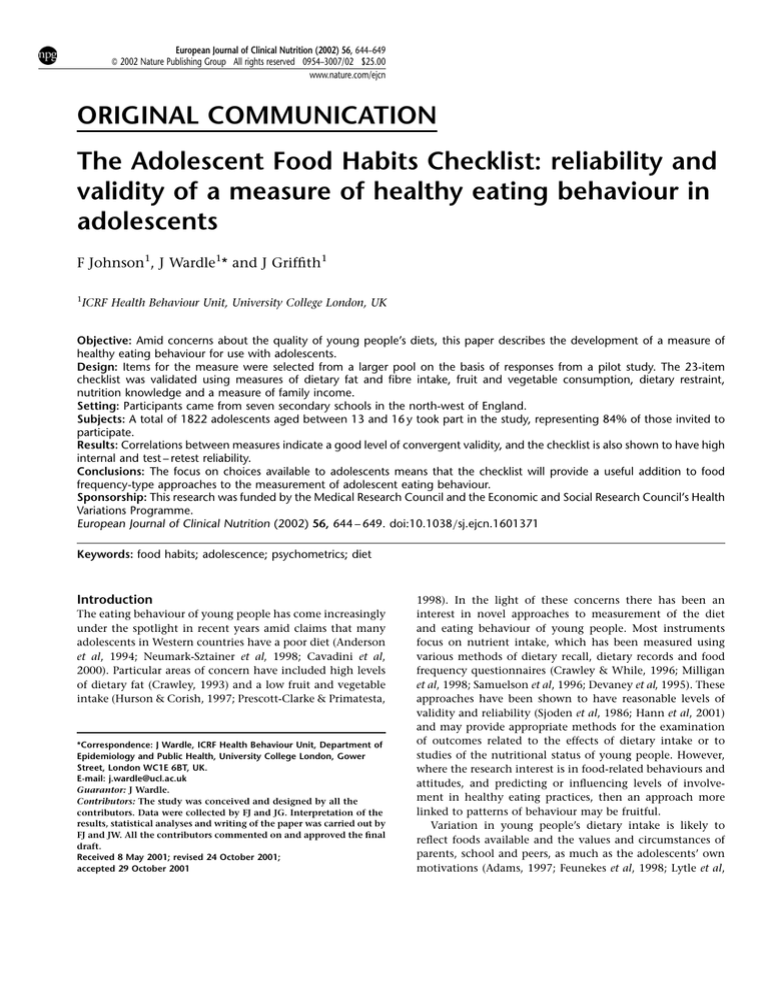
European Journal of Clinical Nutrition (2002) 56, 644–649
ß 2002 Nature Publishing Group All rights reserved 0954–3007/02 $25.00
www.nature.com/ejcn
ORIGINAL COMMUNICATION
The Adolescent Food Habits Checklist: reliability and
validity of a measure of healthy eating behaviour in
adolescents
F Johnson1, J Wardle1* and J Griffith1
1
ICRF Health Behaviour Unit, University College London, UK
Objective: Amid concerns about the quality of young people’s diets, this paper describes the development of a measure of
healthy eating behaviour for use with adolescents.
Design: Items for the measure were selected from a larger pool on the basis of responses from a pilot study. The 23-item
checklist was validated using measures of dietary fat and fibre intake, fruit and vegetable consumption, dietary restraint,
nutrition knowledge and a measure of family income.
Setting: Participants came from seven secondary schools in the north-west of England.
Subjects: A total of 1822 adolescents aged between 13 and 16 y took part in the study, representing 84% of those invited to
participate.
Results: Correlations between measures indicate a good level of convergent validity, and the checklist is also shown to have high
internal and test – retest reliability.
Conclusions: The focus on choices available to adolescents means that the checklist will provide a useful addition to food
frequency-type approaches to the measurement of adolescent eating behaviour.
Sponsorship: This research was funded by the Medical Research Council and the Economic and Social Research Council’s Health
Variations Programme.
European Journal of Clinical Nutrition (2002) 56, 644 – 649. doi:10.1038=sj.ejcn.1601371
Keywords: food habits; adolescence; psychometrics; diet
Introduction
The eating behaviour of young people has come increasingly
under the spotlight in recent years amid claims that many
adolescents in Western countries have a poor diet (Anderson
et al, 1994; Neumark-Sztainer et al, 1998; Cavadini et al,
2000). Particular areas of concern have included high levels
of dietary fat (Crawley, 1993) and a low fruit and vegetable
intake (Hurson & Corish, 1997; Prescott-Clarke & Primatesta,
*Correspondence: J Wardle, ICRF Health Behaviour Unit, Department of
Epidemiology and Public Health, University College London, Gower
Street, London WC1E 6BT, UK.
E-mail: j.wardle@ucl.ac.uk
Guarantor: J Wardle.
Contributors: The study was conceived and designed by all the
contributors. Data were collected by FJ and JG. Interpretation of the
results, statistical analyses and writing of the paper was carried out by
FJ and JW. All the contributors commented on and approved the final
draft.
Received 8 May 2001; revised 24 October 2001;
accepted 29 October 2001
1998). In the light of these concerns there has been an
interest in novel approaches to measurement of the diet
and eating behaviour of young people. Most instruments
focus on nutrient intake, which has been measured using
various methods of dietary recall, dietary records and food
frequency questionnaires (Crawley & While, 1996; Milligan
et al, 1998; Samuelson et al, 1996; Devaney et al, 1995). These
approaches have been shown to have reasonable levels of
validity and reliability (Sjoden et al, 1986; Hann et al, 2001)
and may provide appropriate methods for the examination
of outcomes related to the effects of dietary intake or to
studies of the nutritional status of young people. However,
where the research interest is in food-related behaviours and
attitudes, and predicting or influencing levels of involvement in healthy eating practices, then an approach more
linked to patterns of behaviour may be fruitful.
Variation in young people’s dietary intake is likely to
reflect foods available and the values and circumstances of
parents, school and peers, as much as the adolescents’ own
motivations (Adams, 1997; Feunekes et al, 1998; Lytle et al,
The adolescent food habits checklist
F Johnson et al
645
1996). Nonetheless, there are many opportunities for young
people to make personal food choices, which makes it
important to examine the more voluntary aspects of healthy
eating. Most adolescents are economically active, at least to
the extent of having the resources to buy snacks, and they
consume snack foods more frequently than adults (Anderson
et al, 1993). Some adolescents will be involved in the purchase and preparation of food at home, and many will
choose their own meals at school. Adolescents can also
refuse food offered to them. Looking at patterns of eating
behaviour in situations in which young people are likely to
be able to make personal choices may provide a useful
complement to assessing dietary intake.
There have been a number of approaches to the measurement of healthy eating from a behavioural rather than a
simply nutritional perspective. Some studies have focused on
measuring a small number of specific ‘healthy’ or
‘unhealthy’ practices such as snacking or eating breakfast
(Steptoe & Wardle, 1999; Monneuse et al, 1997; Speed et al,
1998; Wardle et al, 2000a). These measures have not, however, attempted to assess a broad range of food habits, or the
balance between healthy and unhealthy practices in an
individual’s eating patterns, but have tended to be more
concerned with the covariance of a small number of food
habits with other behaviours. Kristal et al (1990) developed a
more comprehensive adult measure of fat-related healthy
habits, which was later expanded to incorporate fibre-related
items (Shannon et al, 1997). This scale asks questions about
modification of foods so as to lower their fat content,
avoidance of high-fat foods, substitution of low-fat alternative foods, and selection of fruit, vegetables and other highfibre foods. Although the scale has the advantage of focusing
on food choices in relation to specific situations, its orientation towards North American foodstuffs and inclusion of
items relating to the purchase and preparation of food, limits
its value with British adolescents. Another fat avoidance
scale designed for use with a Mexican-American population
(Knapp et al, 1988) presents similar obstacles for use with
British young people.
The scale presented here, the Adolescent Food Habits
Checklist (AFHC), aims to provide a measure of adolescent
healthy eating behaviour with reference to those situations
in which young people are likely to have a degree of personal
control. It addresses areas in which adolescents may be able
to affect how closely their diets conform to guidelines on
healthy eating, with reference to the avoidance of specific
energy-dense foods, selection of low-fat alternatives, consumption of fruit and vegetables and snacking behaviour. In
order to assess the convergent validity of the AFHC, a
number of hypotheses were generated with regard to the
associations between AFHC score and scores on other related
measures. It was predicted that girls would score more highly
on the AFHC than boys, since young women are known to
involve themselves in healthy eating to a greater degree than
young men (Anderson et al, 1994; Prescott-Clarke & Primatesta, 1998). Many of the items of the AFHC refer to low-fat
eating behaviours, and so a strong, negative correlation was
expected between dietary fat intake and AFHC score. Similarly, the relationship between AFHC score and daily fruit
and vegetable intake was hypothesised to be strongly positive. Items on the checklist are relevant to dietary fibre intake
through questions on fruit and vegetable consumption, and
so a positive but weaker correlation was also predicted
between dietary fibre and AFHC score. A positive correlation
with family affluence was also predicted, as social class and
income have both been associated with healthier eating
practices (Margetts et al, 1998; Johansson et al, 1999).
Furthermore the major role played by healthy eating in
weight control (Nichter et al, 1995) meant that AFHC was
hypothesised to be positively associated with dietary
restraint. Finally, nutrition knowledge has been linked with
a more healthy diet in some studies (Wardle et al, 2000b),
and such an association was predicted here.
Method
Participants
Participants for this study were 1822 adolescents, aged
between 13 and 16 (mean age 14 y 5 months) participating
in a larger study of health and weight related behaviour in
adolescents in the north-west of England, which received
ethical approval from the Joint UCL=UCLH Committee on
the Ethics of Human Research. Girls’ and mixed-sex schools
in Wirral and West Cheshire were classified for levels of
social deprivation (high, intermediate and low) according
to the number of pupils eligible to receive free school meals.
A stratified sample of seven schools was selected, incorporating at least one girls’ and one mixed school from each of the
three levels. All pupils in school years 9 and 10 at the seven
schools were invited to participate, and the sample was 68%
female. Data were collected during class sessions by researchers who visited the school, and usable data were obtained
from 84% of pupils enrolled in the eligible year groups at the
seven participating schools. Missing data were predominantly because of absence from class on the day of the
survey (15%). Less than 2% of those eligible refused to
participate or were withdrawn by parents.
Materials
Adolescent Food Habits Checklist
Item selection. Items were selected for the AFHC on the
basis of findings from a pilot study carried out with 178
adolescent girls attending an independent girls’ school in the
north-west of England (mean age 15 y 10 months). A preliminary pool of 70 items for the AFHC were generated with
reference to existing literature, and dietary health recommendations and in discussion with health psychologists and
nutritionists. Participants were asked to reply ‘true’ or ‘false’
or ‘not applicable to me’ with regard to whether they usually
followed specific dietary practices. These practices included
the purchase, preparation and consumption of specific
European Journal of Clinical Nutrition
The adolescent food habits checklist
F Johnson et al
646
foods, as well as snacking habits. Items referred to both
healthy and unhealthy behaviours. Participants were also
asked to add any other things that they regularly did in order
to make their diet more healthy.
Analysis of pilot data. Responses to the pilot questionnaire
were analysed first using factor analysis with varimax rotation in order to establish whether there was a multidimensional structure underlying the patterning of food habits.
Results from this analysis suggested a weak factor structure. A
five-factor solution accounted for just 32% of the variance,
and intercorrelations between factors were high. Internal
reliability for the item pool as a whole was good (Cronbach’s
a ¼ 0.91). In light of the weakness of the factors, and other
evidence that healthy eating patterns often do not form
stable, replicable factors (Birkett & Boulet, 1995; Prewitt
et al, 1997), items for the final scale were selected according
to other criteria. It was decided to limit the scale to items
pertaining to intake of fruit, vegetables and energy-dense
foods. Items with a low item-total correlation (r < 0.20) and
those which made reference to situations likely to be unfamiliar to adolescents were omitted from the scale. Four items
referring to general aims to eat a diet that is low in fat, low in
sugar, high in fruit and vegetables and healthy were retained.
No items were added in response to comments from the pilot
sample as no widely used practices emerged from these
comments. This resulted in a 23-item scale, which had an
internal reliability of Cronbach’s a ¼ 0.83 in the pilot sample.
The 23 items of the AFHC are shown in Appendix 1. A
true=false response format was selected to make the checklist
easier to complete. Ten items also had an alternative
response, equivalent to ‘not applicable’. Participants received
one point for each ‘healthy’ response. The final score was
adjusted for ‘not applicable’ and missing responses using the
formula: AFHC score ¼ no of ‘healthy’ responses(23=no. of
items completed).
potatoes) they ate in a usual day. Responses to these two
questions were summed to provide a score for daily intake of
fruit and vegetables. This assessed proximity to the minimum
five portions of fruit and vegetables a day recommended for a
healthy diet (World Health Organization, 1990).
Dietary restraint
A shortened, five-item version of the restraint subscale of the
Dutch Eating Behaviour Questionnaire (DEBQ; Van Strien
et al, 1986) was included. The scale was abbreviated on the
basis of factor loadings reported by the authors and others
(Van Strien et al, 1986; Wardle, 1987).
Nutrition Knowledge
Nutrition knowledge was measured using an adapted version
of the Nutrition Knowledge Questionnaire (Parmenter &
Wardle, 1999). This questionnaire examines knowledge of
dietary guidelines, fat content of common foods and diet –
disease relationships.
Household affluence
Participants responded to four items, asking about housing
tenure, eligibility to receive free school meals, and family
ownership of one or more cars and a computer. This scale has
been found to correlate significantly with the Townsend area
level indicator of deprivation (Townsend et al, 1988; Wardle
et al, in press).
A number of demographic questions were included in
order to characterise the participants in the study. These
included sex, age, ethnicity and whether individuals had
been trying to gain or lose weight in the past 12 months.
Results
Test – retest reliability. The test – retest reliability of the 23item AFHC was examined using a sample of 24 adolescents
aged between 13 and 14 y (mean age 13 y 8 months). Participants completed the AFHC twice, with a delay of 2 weeks
between the two completions. The correlation between score
at T1 and score at T2 was very high (r ¼ 0.90 P < 0.001).
Dietary fat and fibre intake
Levels of dietary fat and fibre intake were measured using a
version of the Dietary Instrument for Nutrition Education
(DINE; Roe et al, 1994). This food frequency questionnaire
was slightly modified for self-report use with adolescents.
Daily intake of fruit and vegetables
Participants were asked how many portions of fruit (fresh,
frozen or tinned) they ate in a usual day, and how many
portions of vegetables (fresh, frozen or tinned, not including
European Journal of Clinical Nutrition
Characteristics of the sample are indicated in Table 1. Over
90% of participants were white, and around one-third came
from low-income families as indicated by their eligibility to
receive free school meals. Girls were, on average one month
older than boys in the sample (F(1, 1787) ¼ 7.7, P < 0.01). The
most striking difference between boys and girls in the sample
was in the numbers attempting to change their body size in
the past 6 months (w2(d.f. ¼ 2) ¼ 173.3, P < 0.001). Girls were
more than twice as likely as boys to be trying to reduce their
body size (55 vs 22%), whilst almost four times as many boys
as girls were trying to increase their body size (8 vs 2%).
Internal reliability of the AFHC in the main study was
high (Cronbach’s a ¼ 0.82), and similar to that found in the
pilot sample. Data were analysed separately for boys and girls
(Table 2). Significant sex differences emerged for all the
variables except family affluence (F(1, 1796) ¼ 3.0, NS).
Girls reported more healthy habits than boys (F(1,
1821) ¼ 92.3, P < 0.001). They also had lower levels of dietary
fat (F(1, 1812) ¼ 164.6, P < 0.001) and fibre (F(1,
The adolescent food habits checklist
F Johnson et al
647
1811) ¼ 49.0, P < 0.001), and consumed more fruit and vegetables (F(1, 1818) ¼ 10.1, P < 0.01). Higher levels of dietary
restraint (F(1, 1812) ¼ 218.8, P < 0.001) and nutrition knowledge (F(1, 1590) ¼ 9.5, P < 0.01) were also associated with
being female.
To examine convergent validity, correlations between
AFHC and the other variables were calculated (Table 3). As
predicted, among both boys and girls a strong negative
correlation was observed between AFHC score and levels of
dietary fat. Similarly, daily fruit and vegetable intake and
AFHC score was strongly associated for both sexes. The
correlation with dietary fibre was less strong but still highly
significant and in the predicted direction for girls and boys.
Dietary restraint was positively associated with healthy
habits, and those participants who had a higher level of
knowledge about dietary health and nutrition engaged in
more healthy practices. AFHC score was also associated with
affluence, such that adolescents from more affluent families
reported more healthy eating behaviours.
Table 3 Correlations between AFHC and validation measures
Girls
(n ¼ 1246)
Boys
(n ¼ 576)
Total
(n ¼ 1822)
0.44
7 0.41
0.18
0.39
0.14
0.16
0.45
7 0.46
0.24
0.43
0.18
0.13
0.45
7 0.46
0.16
0.43
0.17
0.14
Fruit and vegetable intake
DINE — dietary fat
DINE — dietary fibre
DEBQ — dietary restraint
Nutrition knowledge questionnaire
Family affluence
All correlations significant at P < 0.001.
Table 1 Sample characteristics
Girls
(n ¼ 1246)
Boys
(n ¼ 576)
Significance of gender differences
Age (s.d.)
14 y 5 months (6.9 months) 14 y 4 months (7.7 months)
Ethnicity
White
1149 (92.1%)
517 (89.8%)
Non-white
85 (6.8%)
59 (6.4%)
Missing
14 (1.1%)
22 (3.8%)
Deprivation
Eligible for free school meals
393 (32.0%)
184 (33.1%)
School type
Single sex
636 (51.0%)
—
Mixed sex
612 (49.0%)
576 (100%)
Trying to change body weight
Lose weight
688 (55.2%)
129 (22.4%)
Gain weight
27 (2.2%)
48 (8.3%)
Stay the same=do nothing
512 (41.1%)
364 (63.2%)
Missing
19 (1.5%)
33 (5.7%)
Table 2
F(1, 1787) ¼ 7.7, P < 0.01
w2[1] ¼ 0.03, NS
2
w [1] ¼ 0.21, NS
N=A
2
w [2] ¼ 173.3, P < 0.001
Scores for each measure divided by gender
Adolescent Food Habits Checklist
Mean
(s.d.)
Fruit and vegetable intake (servings per day)
Mean
(s.d.)
DINE — dietary fat score
Mean
(s.d.)
DINE — dietary fibre score
Mean
(s.d.)
DEBQ — dietary restraint
Mean
(s.d.)
Nutrition knowledge questionnaire
Mean
(s.d.)
Family affluence
Mean
(s.d.)
Girls
(n ¼ 1246)
Boys
(n ¼ 576)
Total
(n ¼ 1822)
11.7
(4.7)
9.4
(5.0)
11.0
(4.9)
F(1, 1821) ¼ 92.3, P < 0.001
3.9
(2.2)
3.5
(2.3)
3.8
(2.3)
F(1, 1818) ¼ 10.1, P < 0.01
27.1
(9.7)
34.2
(12.9)
29.4
(11.3)
F(1, 1812) ¼ 164.6, P < 0.001
26.4
(8.8)
29.6
(9.8)
27.4
(9.3)
F(1, 1811) ¼ 49.0, P < 0.001
12.0
(5.2)
8.4
(3.9)
10.9
(5.1)
F(1, 1812) ¼ 218.8, P < 0.001
12.0
(2.7)
11.5
(3.0)
11.8
(2.8)
F(1, 1590) ¼ 9.5, P < 0.01
3.5
(1.4)
3.6
(1.4)
3.5
(1.4)
F(1, 1796) ¼ 3.0, NS
Significance of gender differences
European Journal of Clinical Nutrition
The adolescent food habits checklist
F Johnson et al
648
Several analyses were carried out in order to further investigate the source of gender differences in AFHC scores. To
examine whether the inclusion of single-sex girls’ schools,
but not boys’ schools, may be a factor in the observed gender
differences, the effect of single sex education on girls’ AFHC
scores was examined. No significant effect of school type
emerged (t(1244) ¼ 1.34, NS). In order to examine the possibility that dietary restraint and nutrition knowledge might
mediate gender differences, a stepwise multiple regression
was carried out examining the relationship between gender
and AFHC score whilst controlling for these two variables.
Entering gender alone shows that it accounts for 4.8% of the
variance in AFHC score. If dietary restraint and nutrition
knowledge are entered first they account for 20.4% of the
variance (F(2, 1586) ¼ 204.6, P < 0.001). Entering gender at
step two shows a significant but very small effect (additional
variance ¼ 0.6% F(1, 1585) ¼ 12.9, P < 0.00). This indicates
that dietary restraint and nutrition knowledge account for a
large proportion of the sex differences in AFHC scores, but
gender still makes a small independent contribution.
Discussion
The development of a measure of healthy eating habits
designed specifically for use with adolescents is likely to be
a useful complement to existing methods of dietary assessment. In contrast to other published measures of healthy
eating behaviours the AFHC refers to food choice situations
in which adolescents are likely to have a degree of personal
control. Furthermore, the AFHC focuses specifically on areas
of the adolescent diet which present cause for concern,
particularly the consumption of energy dense foods and
fruit and vegetable intake. Items were selected from a large
pool generated by dietitians and health psychologists, and
adolescents in the pilot group had the opportunity to contribute, which ensured items were relevant both to recommendations for a healthy diet and to the decision-making
opportunities available to adolescents. The resulting instrument has a high level of internal and test – retest reliability.
All a priori predictions regarding associations of the checklist with other measures were supported at a high level of
significance, indicating good convergent validity. High correlations between the AFHC and dietary fat and fruit and
vegetable intake suggest that AFHC is successful in measuring an adequately representative sample of adolescent’s
healthy eating activities, with regard to behaviours linked
to fat and fruit and vegetable consumption.
In common with the findings of other studies, greater
involvement in healthy dietary habits was associated with
being female. The link between dietary restraint and healthy
eating appears to account for a high proportion of these
gender differences, with the better nutrition knowledge of
girls playing a further small role. Nonetheless, a weak relationship between gender and healthy habits remains even
after controlling for both of these factors. One possibility is
that girls’ greater involvement in healthy eating is due in
part to differences both in the value placed on health and
European Journal of Clinical Nutrition
beliefs about the importance of diet between males and
females (Wardle et al, 1997).
The observed association between family affluence and
healthy habits is consistent with the findings of others that
social status and income predict healthier food attitudes and
a better diet (Margetts et al, 1998; Johansson et al, 1999).
Amongst adolescents this relationship may be mediated in
part by snacking behaviour, since a disadvantaged home life
has been linked to less regular meal patterns and a higher
consumption of sweet and fatty snacks in US adolescents
(Siega-Riz et al, 1998).
The AFHC should provide a useful tool for the examination
of healthy eating behaviours in adolescents. In particular, the
orientation of the AFHC towards situations in which adolescents are likely to have a degree of personal choice in their
eating behaviour gives it an advantage over standard foodfrequency-type questionnaires, which may be much influenced by social circumstances and the decision-making of
others. The AFHC measures active investment on the part of
the adolescent in their diet, and so may be of value in
examining the underlying cognitions, attitudes and circumstances that lead to involvement in healthy eating.
References
Adams L (1997): An overview of adolescent eating behaviour barriers
to implementing dietary guidelines. Ann. N.Y. Acad. Sci. 817, 36 –
48.
Anderson AS, MacIntyre S & West P (1993): Adolescent meal patterns: grazing habits in the west of Scotland. Health Bull. (Edinb.)
51, 158 – 165.
Anderson AS, MacIntyre S & West P (1994): Dietary patterns among
adolescents in the west of Scotland. Br. J. Nutr. 71, 111 – 122.
Birkett NJ & Boulet J (1995): Validation of a food habits questionnaire: poor performance in male manual labourers. J. Am. Diet.
Assoc. 95, 558 – 563.
Cavadini C, Siega-Riz AM & Popkin BM (2000): US adolescent food
intake trends from 1965 – 1996. Arch. Dis. Child. 83, 18 – 24.
Crawley HF (1993): The energy, nutrient and food intakes of teenagers aged 16 – 17 y in Britain. (1) Energy, macronutrients and
non-starch polysaccarides. Br. J. Nutr. 70, 15 – 26.
Crawley HF & While D (1996): Parental smoking and the nutrient
intake and food choice of British teenagers aged 16 – 17 y. J.
Epidemiol. Community Health 50, 306 – 312.
Devaney BL, Gordon AR & Burghardt JA (1995): Dietary intakes of
students. Am. J. Clin. Nutr. 61, 205s – 212s.
Feunekes GI, de Graaf C, Meyboom S & van Staveren WA (1998):
Food choice and fat intake of adolescents and adults: associations
of intakes within social networks. Prev. Med. 27, 645 – 656.
Hann CS, Rock CL, King I & Drewnowski A (2001): Validation of the
Healthy Eating Index with use of plasma biomarkers in a clinical
sample of women. Am. J. Clin. Nutr. 74, 479 – 486.
Hurson M & Corish C (1997): Evaluation of lifestyle, food consumption and nutrient intake patterns among Irish teenagers. Ir. J. Med.
Sci. 166, 225 – 230.
Johansson L, Thelle DS, Solvoll K, Bjorneboe GE & Drevon CA
(1999): Healthy dietary habits in relation to social determinants
and lifestyle factors. Br. J. Nutr. 81, 211 – 220.
Knapp JA, Hazuda HP, Haffner SM, Young EA & Stern MP (1988): A
saturated fat=cholesterol avoidance scale: sex and ethnic differences in a biethnic population. J. Am. Diet. Assoc. 88, 172 – 177.
Kristal AR, Shattuck AL & Henry HJ (1990): Patterns of dietary
behavior associated with selecting diets low in fat: reliability and
validity of a behavioural approach to dietary assessment. J. Am.
Diet. Assoc. 90, 214 – 220.
The adolescent food habits checklist
F Johnson et al
Lytle LA, Stone EJ, Nichaman MZ, Perry CL, Montgomery DH,
Nicklas TA et al (1996): Changes in nutrient intakes of elementary
school children following a school-based intervention: results of
the CATCH study. Prev. Med. 25, 465 – 477.
Margetts BM, Thompson RL, Speller V & McVey D (1998): Factors
which influence ‘healthy’ eating patterns: results from the 1993
Health Education Authority health and lifestyle survey in England. Public Health Nutr. 1, 193 – 198.
Milligan RA, Burke V, Beilin LJ, Dunbar DL, Spencer MJ, Balde E &
Gracey MP (1998): Influence of gender and socioeconomic status
on dietary patterns and nutrient intakes in 18 y old Australians.
Aust. N.Z. J. Public Health 22, 485 – 493.
Monneuse MO, Bellisle F & Koppert G (1997): Eating habits, food and
health related attitudes and beliefs reported by French students.
Eur. J. Clin. Nutr. 51, 46 – 53.
Neumark-Sztainer D, Story M, Resnick MD & Blum RW (1998):
Lessons learned about adolescent nutrition from the Minnesota
Adolescent Health Survey. J. Am. Diet. Assoc. 98, 1449 – 1456.
Nichter M, Ritenbaugh C, Nichter M, Vuckovic N & Aickin M (1995):
Dieting and watching behaviours among adolescent females:
report of a multimethod study. J. Adolesc. Health 17, 153 – 162.
Parmenter K & Wardle J (1999): Development of a Nutrition Knowledge Questionnaire. Eur. J. Clin. Nutr. 53, 298 – 308.
Prescott-Clarke P & Primatesta P (1998): Health Survey for England:
The Health of Young People 1995 – 1997. London: The Stationery
Office.
Prewitt TE, Durazo-Arvisu R, McGee DL, Luke A & Cooper RS (1997):
One size fits all: implications for assessing dietary behaviour. J. Am.
Diet. Assoc. 97, s70 – s72.
Roe L, Strong C, Whiteside C, Neil A & Mant D (1994): Dietary
assessment in primary care: validity of the DINE method for
dietary assessment. Fam. Pract. 11, 375 – 381.
Samuelson G, Bratteby LE, Enghardt H & Hedgren M (1996): Food
habits and energy and nutrient intake in Swedish adolescents
approaching the year 2000. Acta Paediatr. 415(Suppl), 1 – 19.
Shannon J, Kristal AR, Curry SJ & Beresford SA (1997): Application of
a behavioral approach to measuring dietary change: the fat and
fibre related diet questionnaire. Cancer Epidemiol. Biomarkers Prev.
6, 355 – 361.
Siega-Riz AM, Carson T & Popkin B (1998): Three squares or mostly
snacks — what do teens really eat? A sociodemographic study of
meal patterns. J. Adolesc. Health 22, 29 – 36.
Sjoden P, Fellenius J & Lappalainen R (1986): Assessment methods for
eating behavior, food intake and food preferences. Scand. J. Behav.
Ther. 15, 163 – 177.
Speed E, West P & Sweeting H (1998): The west of Scotland 11 – 16
study. Basic frequencies of the 13 y old (S2) sweep. MRC Medical
Sociology Unit Working Paper no. 66.
Steptoe A & Wardle J (1999): Motivational factors as mediators of
socioeconomic variation in dietary intake patterns. Psychol Health
14, 391 – 402.
Townsend P, Phillimore P & Beattie A (1988): Health and deprivation:
inequality and the north. London: Croom Helm.
Van Strien T, Frijters JE, Bergers GP & Defares PB (1986): The Dutch
Eating Behaviour Questionnaire (DEBQ) for assessment of
restrained, emotional and external eating behaviour. Int. J. Eat.
Disord 5, 295 – 315.
Wardle J (1987): Eating style: a validation of the Dutch Eating
Behaviour Questionnaire in normal subjects and women with
eating disorders. J. Psychosom. Res. 31, 161 – 169.
Wardle J, Steptoe A, Bellisle F, Davou B, Reschke K, Lappalainen R &
Fredrikson M (1997): Healthy Dietary practices among European
students. Health Psychol. 16, 443 – 450.
Wardle J, Griffith J, Johnson F & Rapoport L (2000a): Intentional
weight control and food choice habits in a national representative
sample of adults in the UK. Int. J. Obes. Relat. Metab. Disord. 24,
534 – 540.
Wardle J, Parmenter K & Waller J (2000b): Nutrition knowledge and
food intake. Appetite 34, 269 – 275.
Wardle J, Johnson F & Robb K: J. Epidemiol. Community Health
(in press).
World Health Organization (1990): Diet, nutrition and the prevention of
chronic diseases. WHO Technical Report Series no. 797. Geneva:
WHO.
Appendix: The Adolescent Food Habits Checklist
13. I try to ensure I eat plenty of fruit and vegetables.
True=False
14. I often eat sweet snacks between meals. True=False
15. I usually eat at least one serving of vegetables (excluding potatoes) or salad with my evening meal. True=False
16. When I am buying a soft drink, I usually choose a diet
drink. True=False=I never buy soft drinks
17. When I put butter or margarine on bread, I usually
spread it thinly. True=False=I never have butter or margarine on bread
18. If I have a packed lunch, I usually include some chocolate and=or biscuits. True=False=I never have a packed
lunch
19. When I have a snack between meals, I often choose
fruit. True=False=I never eat snacks between meals
20. If I am having a dessert or pudding in a restaurant, I
usually choose the healthiest one. True=False=I never
have desserts in restaurants
21. I often have cream on desserts. True=False=I don’t eat
desserts
22. I eat at least three servings of fruit most days. True=False
23. I generally try to have a healthy diet. True=False
1. If I am having lunch away from home, I often choose a
low-fat option. True=False=I never have lunch away from
home
2. I usually avoid eating fried foods. True=False
3. I usually eat a dessert or pudding if there is one available. True=False
4. I make sure I eat at least one serving of fruit a day.
True=False
5. I try to keep my overall fat intake down. True=False
6. If I am buying crisps, I often choose a low-fat brand.
True=False=I never buy crisps
7. I avoid eating lots of sausages and burgers. True=False=I
never eat sausages or burgers
8. I often buy pastries or cakes. True=False
9. I try to keep my overall sugar intake down. True=False
10. I make sure I eat at least one serving of vegetables or
salad a day. True=False
11. If I am having a dessert at home, I try to have something low in fat. True=False=I don’t eat desserts
12. I rarely eat takeaway meals. True=False
649
European Journal of Clinical Nutrition


